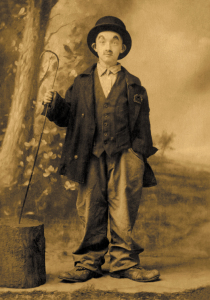“Everything I know I learned in Vaudeville…”
The house lights dim, the music begins and the curtain goes up as the anticipation of what’s to come is electric in the air – the show begins. It’s Vaudeville!
Vaudeville was an enormously popular form of entertainment in the United States from approximately 1880’s well into the 20th Century. It consisted of a number of many acts of varying genres. Some of the acts were of a musical nature but many were not. The acts consisted of singers; instrumentalists; dancers; acrobats; athletes; minstrels; jugglers; animal acts; magicians; slap-stick comedians and burlesque performers.
A staple of the Vaudeville show was a collection of theatrical sketches from various cultural traditions including English Music Hall, Minstrel Shows and Yiddish Theater. This form of live entertainment was so popular that large theaters were packed – often with standing room only. Each performance usually had a dozen or more acts.
In the late 1800’s the rural face of America was changing with the emergence of the Industrial Revolution. People that were farming, planting and reaping crops were leaving the farm obtaining jobs in factories and other businesses. Having a “regular” job meant a weekly or monthly paycheck and some leisure time, that was rare back on the farm. These folks were looking for entertainment that they could afford.
Promoters and producers took advantage of this newly expanded potential audience and went to work providing affordable entertainment in the form of Vaudeville.
It didn’t take long for this form of show business to become the most popular type of entertainment in America. It was affordable for the average working man with a very modest amount of disposable income to spend on entertainment.
Vaudeville promoters provided entertainment for a multiple economic strata of social classes. The venues were classified as “Small Time” “Medium Time” and “Big Time.” The auditorium size and quality of the house was commensurate with the small town stage, compared to New York’s Palace Theater, the queen of Vaudeville houses.
Music
Music was a very important element of Vaudeville. Vaudeville venues had instrumental ensembles that ranged from trios or quartets of various instruments, all the way up to full orchestras. These ensembles played for both the musical and singing acts, but also provided background for the non-musical acts. Many performers had their own musical scores and provided the sheet music for local musicians hired by each theater.
Music ranged from classic opera to ragtime, blues and jazz. Samples of Vaudeville music are: Alexander’s Ragtime Band; The Band Played On; Down by The Old Mill Stream; I Love You Truly; A Pretty Girl Is Like A Melody; Put On Your Old Grey Bonnet; Silver Threads Among The Gold and Ta-ra-ra-Boom-de-ay. These are just some of the popular songs of the era – many other styles and forms of music were also part of Vaudeville music. Ragtime music was very much a part of the revue type show.
Performers
The typical, contemporary American, probably has no idea of how many big-time stars of stage, screen, radio and television, got their start in Vaudeville. Some of the acts were itinerant in nature, moving from town to town, living in hotels for a week or so, then moving on to the next town. It was definitely not a glamorous life or an easy way to make a living. Married performers with children were in the minority. However, some of them traveled with their parents and grew up in show business. Immersed in what their parents did for a living, they naturally evolved into show business. Many of these children made the “Big Time” years later.
Some of the many famous men and women who got their start in Vaudeville are: Will Rogers, Harry Houdini, Al Jolson, The Marx Brothers, W.C. Fields, Jimmy Durante, Abbott and Costello, Judy Garland, Jack Benny, Red Skelton, Bob Hope, Milton Berle, Cary Grant, Eddie Cantor, Fred Allen, Fanny Brice, Burns and Allen, Mae West, Gypsy Rose Lee, Edgar Bergen, Buster Keaton, Kate Smith, Sammy Davis, Jr. and James Cagney, who once said, ”Everything I know I learned in Vaudeville.”
Decline
Unfortunately, the decline of Vaudeville was inevitable after the first decades of the 20th Century. The advent of low-priced cinema contributed greatly to the demise of Vaudeville. The public could see a film for a nickel rather than spend a dollar or two on live entertainment. Vaudeville virtually disappeared in a few short years after flourishing for over 50 years. Many performers were suddenly out of work. Fortunately for some, they found new jobs in the film industry and early radio.
Modern post Vaudeville entertainment was similar in some respects to the Vaudeville of yesteryear. It was revived in the television shows of the 1950’s and early 1960’s on Your Show of Shows, with Sid Caesar and the very popular, Ed Sullivan Show.
What a shame that contemporary audiences cannot enjoy Vaudeville type entertainment the way it used to be. A great part of American theatrical history and entertainment is lost forever.
Please submit your questions and comments to banddirector01@comcast.net
Visit our website at www.danvilleband.org for up-to-date information about the Danville Community Band.
Leave a Reply